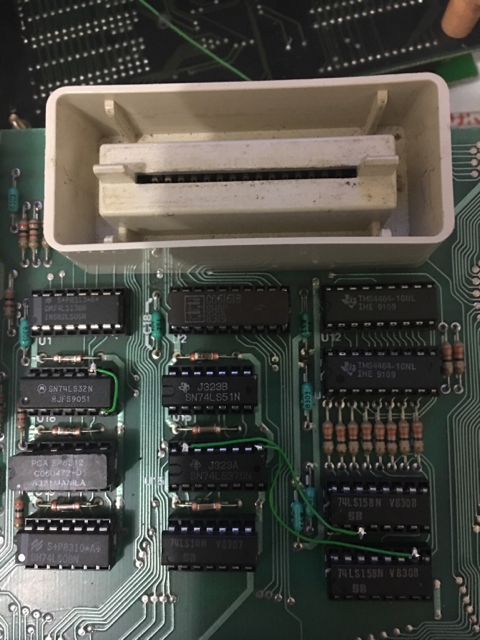Received this board from a friend which booted to a static screen
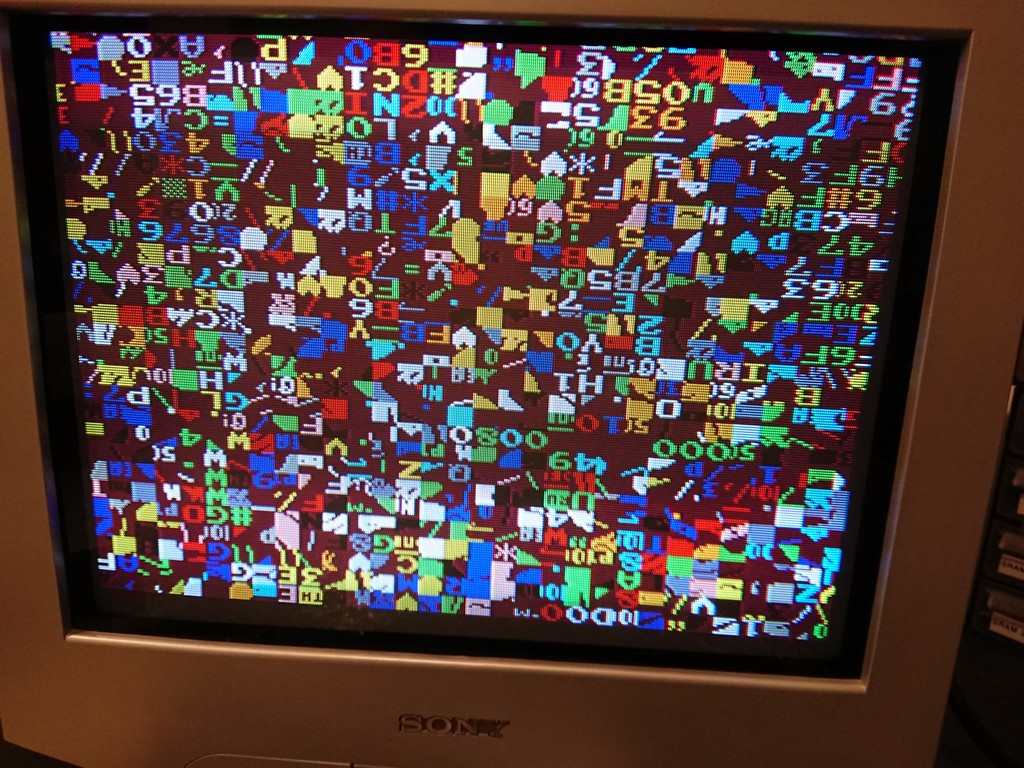
Decided to have a look immediately to the 2k work ram which was a Toshiba which is normally prone to faults.
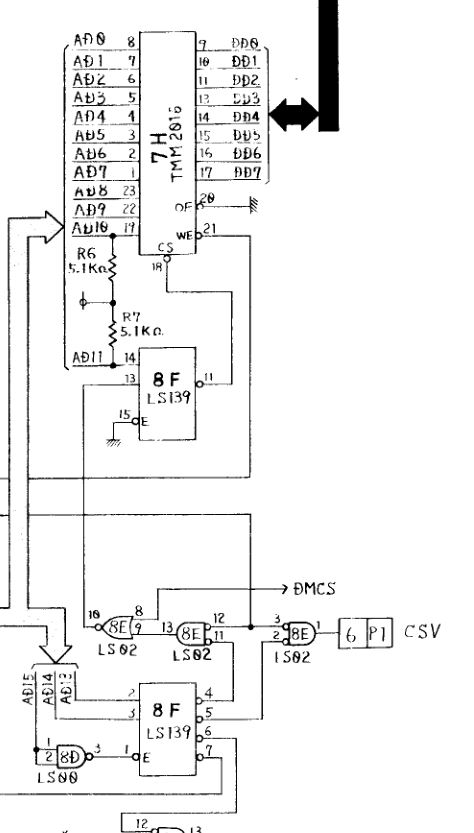
Changed with an Hitachi 2k
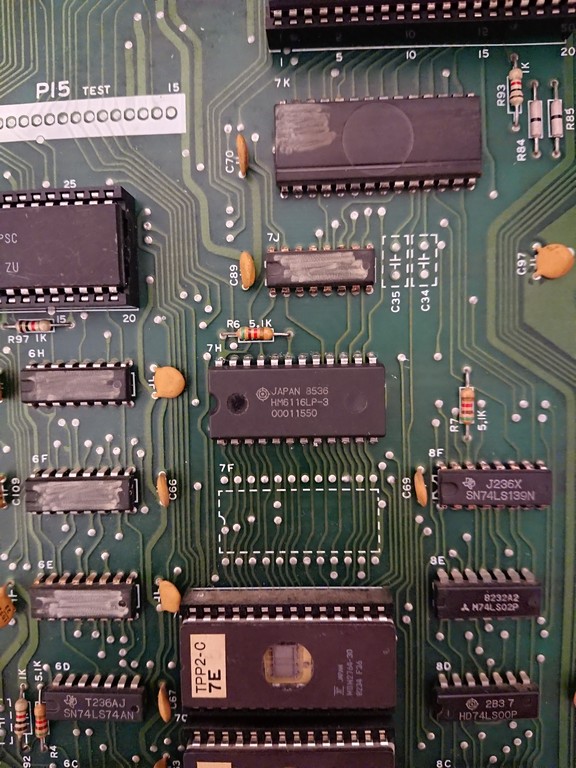
And game 100% fixed with no other errors

Received this board from a friend which booted to a static screen

Decided to have a look immediately to the 2k work ram which was a Toshiba which is normally prone to faults.

Changed with an Hitachi 2k

And game 100% fixed with no other errors

Received for repair from New Zealand this The New Zealand Story PCB (sorry for the wordplay…), the one layer hardware revision :
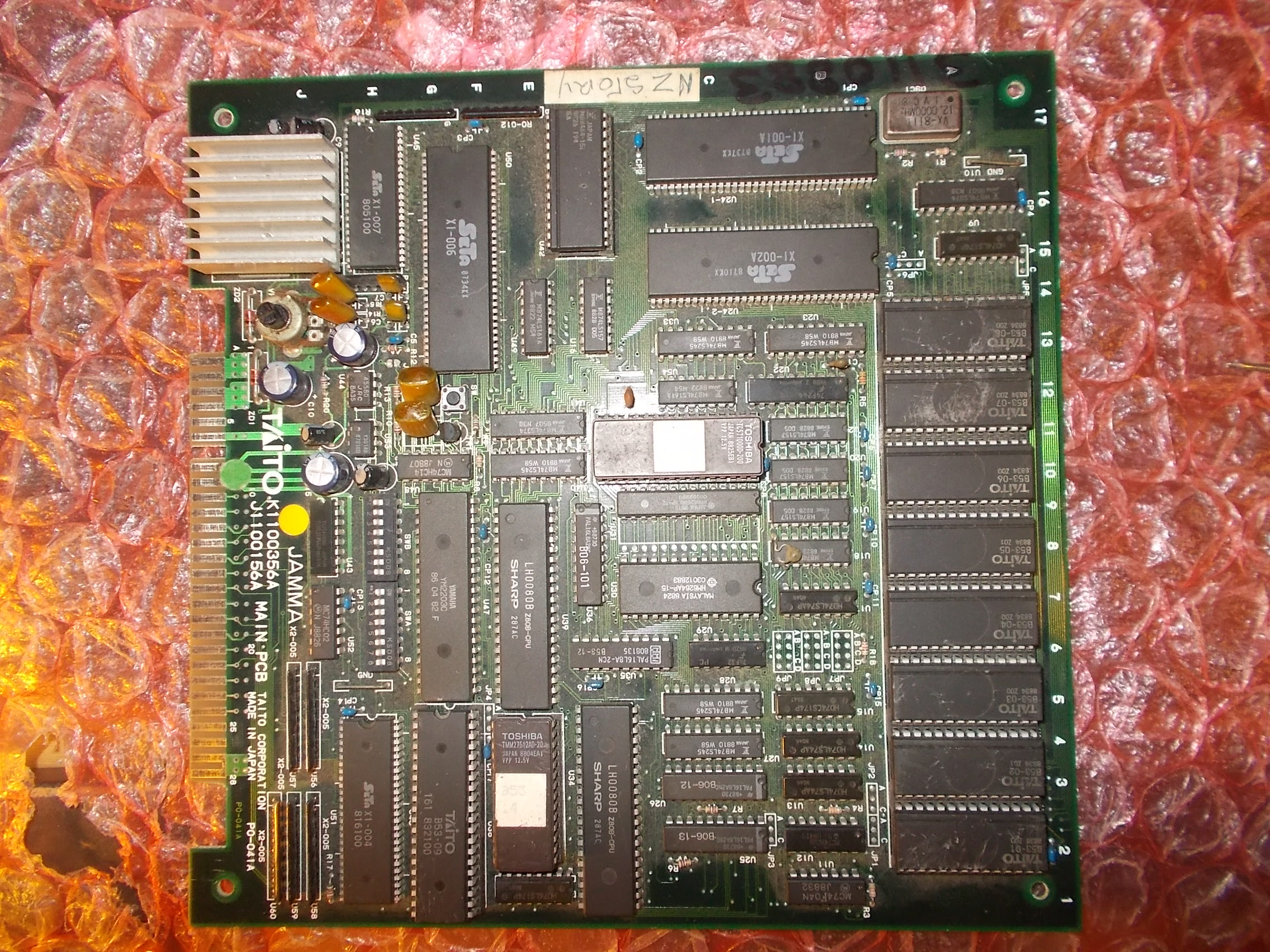
Board booted up but graphics were totally wrong :
GFX data are stored in eight 28 pin 1Mbit MASK ROMs whose pinout is pretty identical to 32 pin 1Mbit non-JEDEC EPROM (extra pins apart)
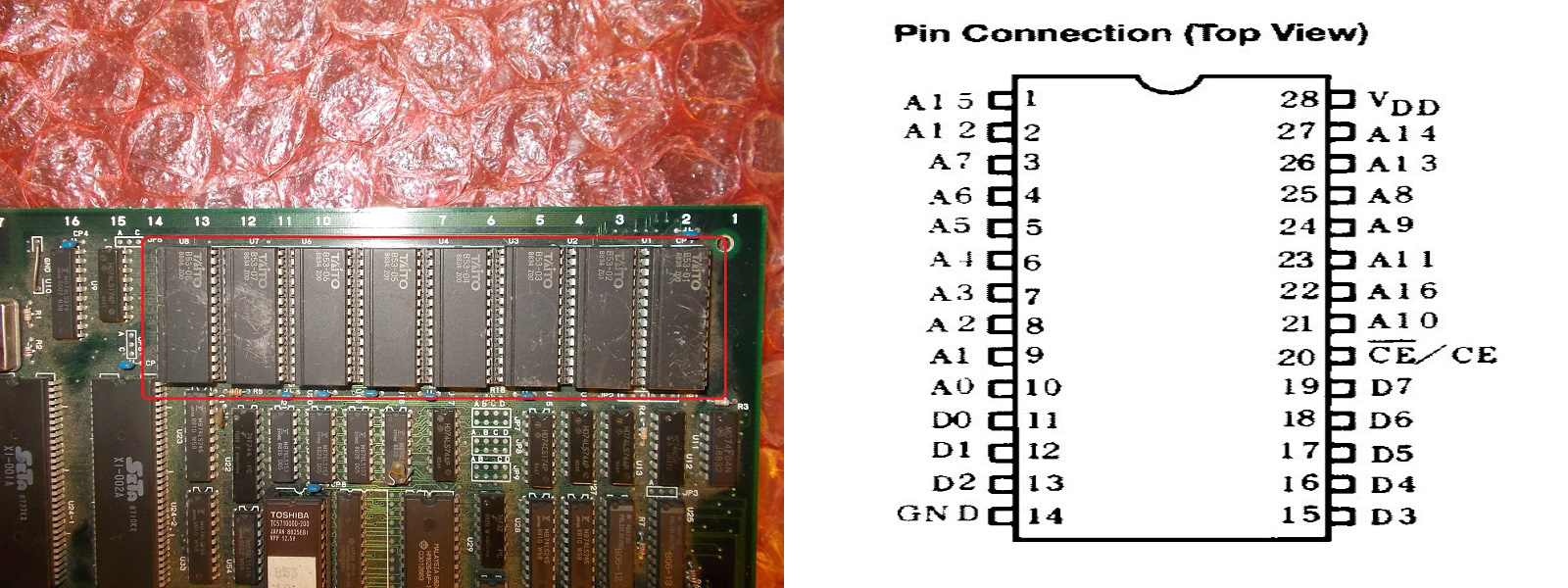
Before dumping them I used my logic probe and found stuck upper address lines (pin 12-13-14-15)
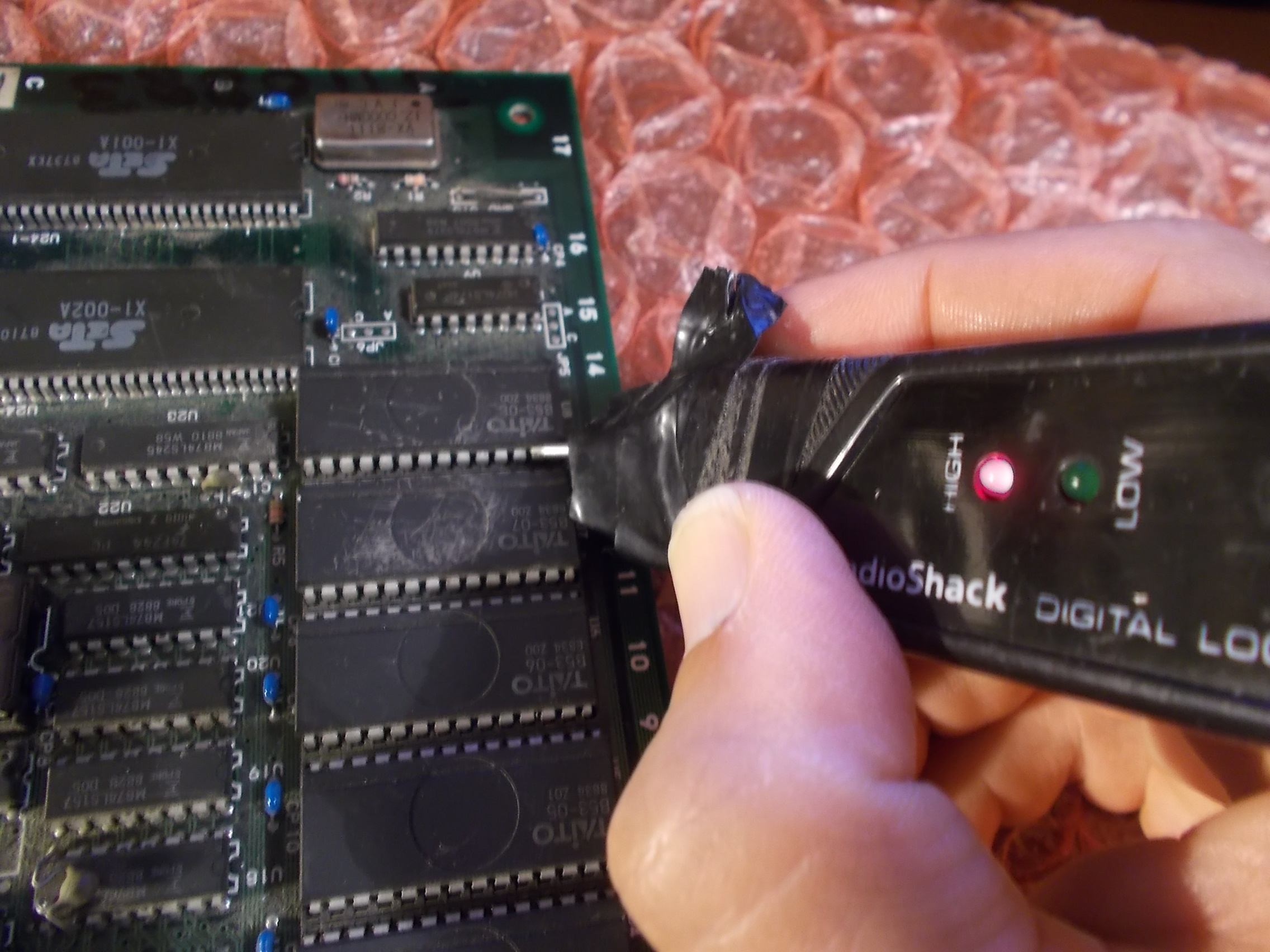
I traced the address lines back to outputs of a 74LS174 @U9 whose inputs were floating, these came from a Fujitsu 74LS374 @U41:
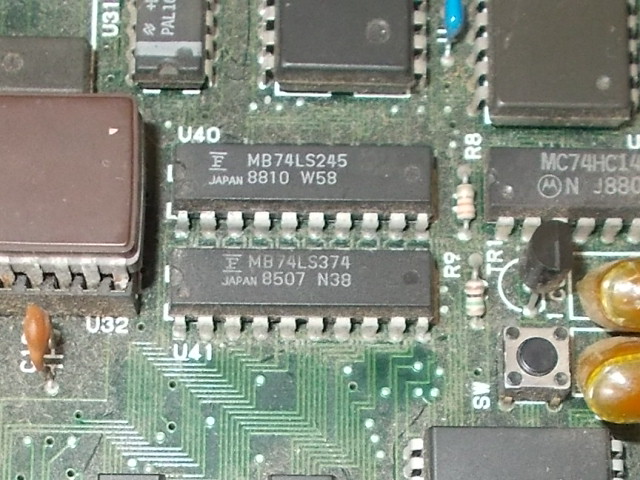
Inputs of it were toggling but all outputs were stuck at undefined voltage level of 1.48V, this is the typical way of failure of Fujitsu TTLs :

The chip failed the out-of-circuit testing, all outputs were indeed in ‘Z’ (or high-impedance if you prefer) state :
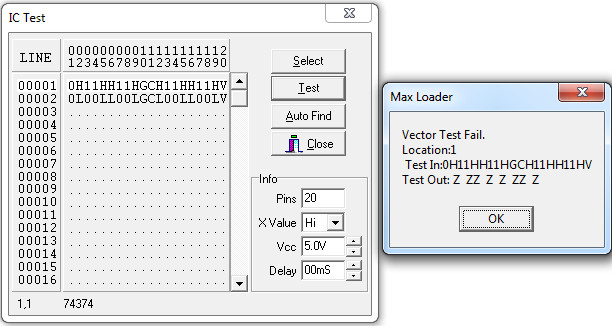
Once replaced the IC the graphics were restored but I noticed some corruption on title screen :
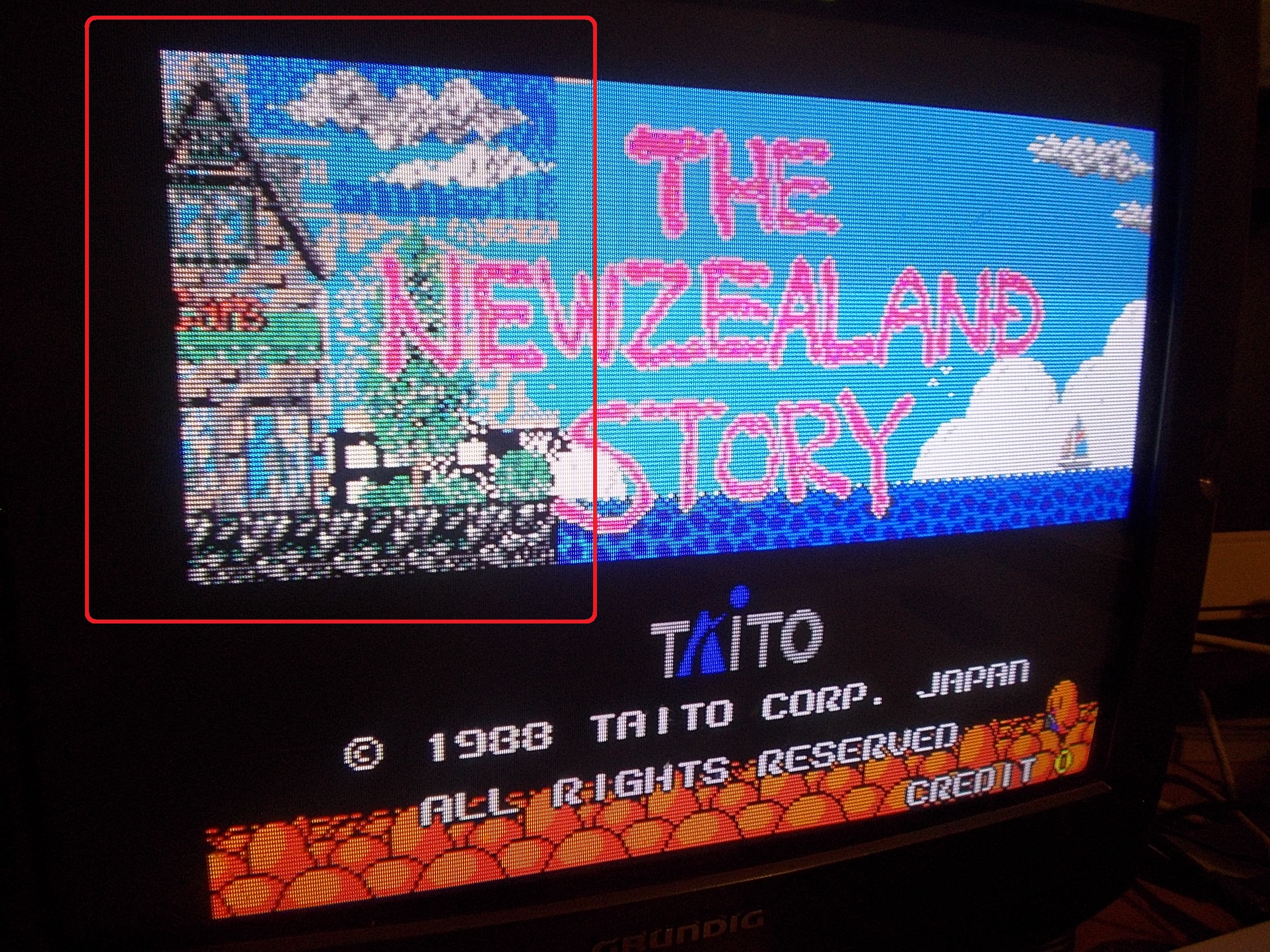
I dumped the 1Mbit MASK ROMs and my programmer complained about the one @U7 :
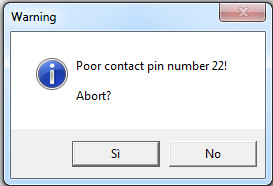
This was a good chance to use one of my adapters I designed some time ago for replacing the 28 pin 1Mbit MASK ROMs with a TSSOP Flash ROM
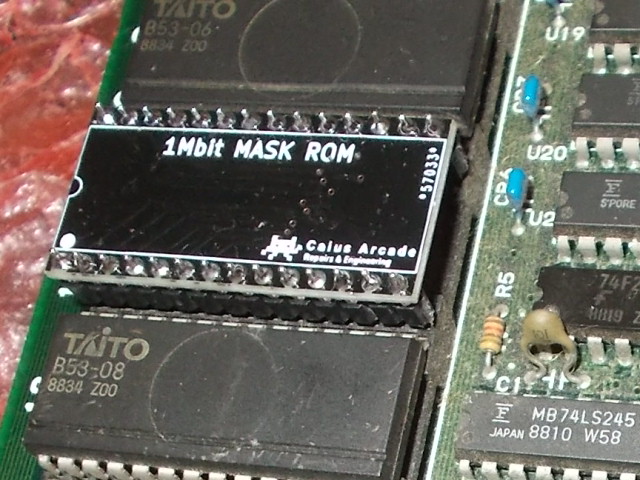
But suddenly during power cycling the graphics went bad again :
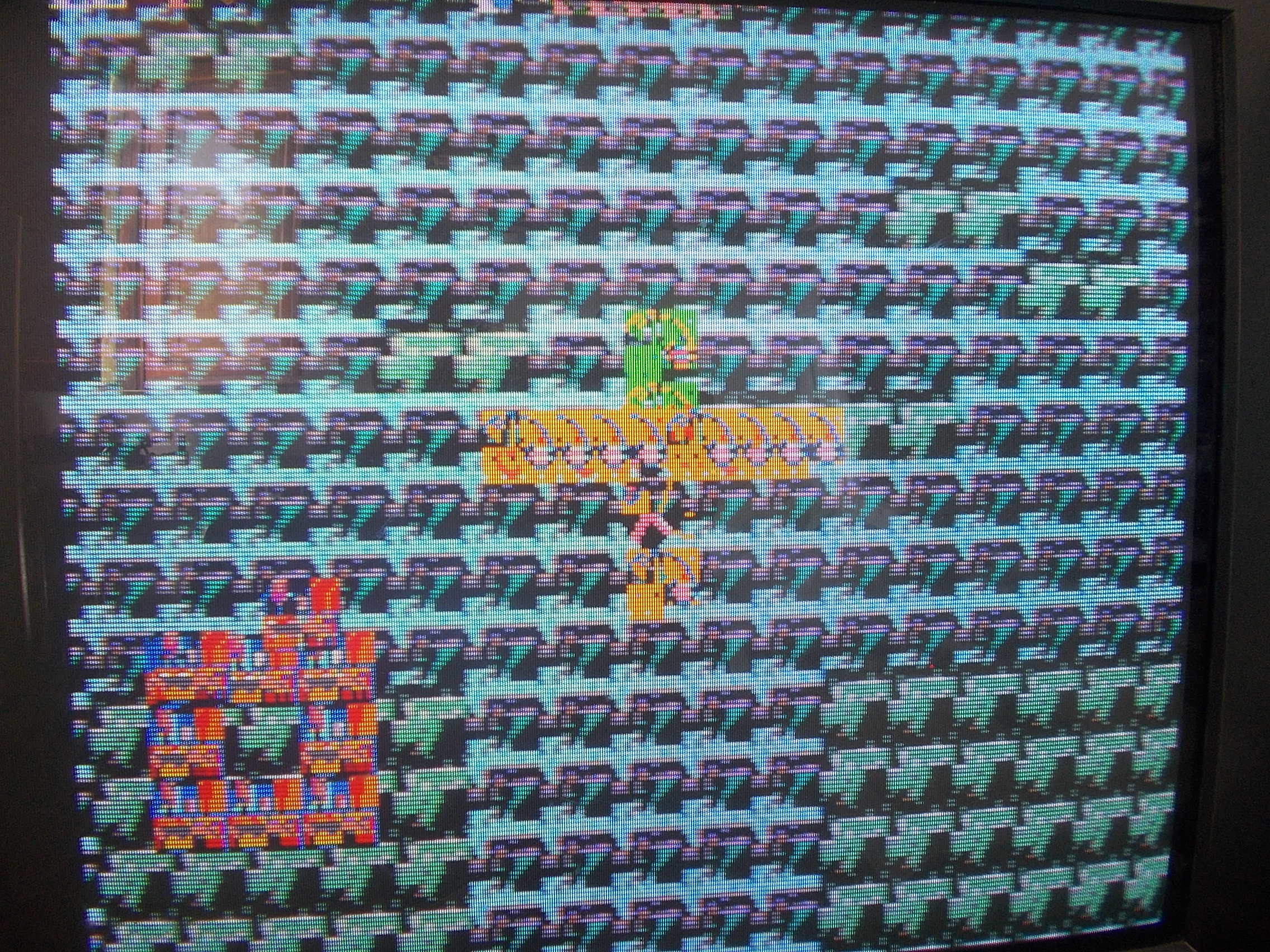
I quickly pinpointed the fault to another 74LS374 @U10 with floating outputs, another Fujitsu one obviously :
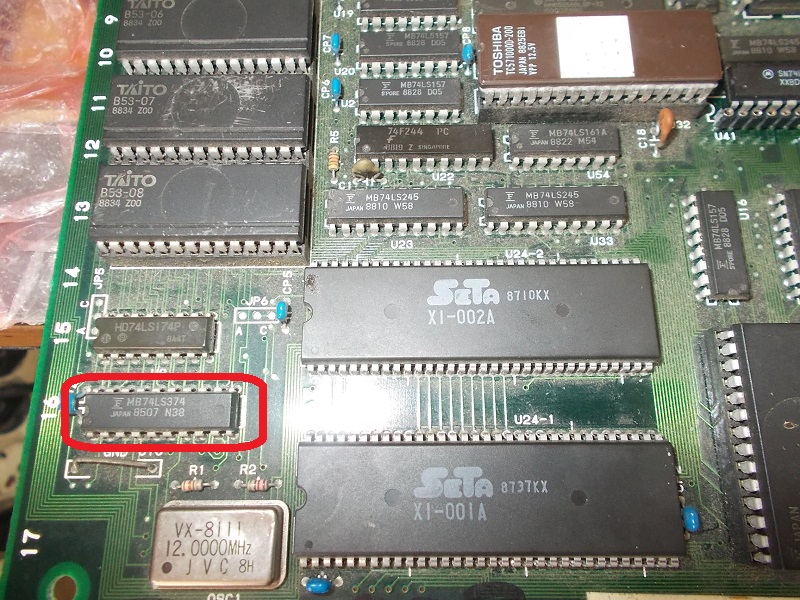
Chip totally failed the out-of-circuit testing:
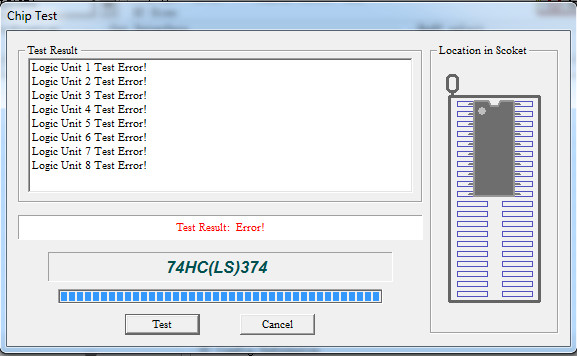
Graphics were now perfect so I started a game but controls didn’t work, the main character of both players moved by itself:
Looking at hardware I figured out the I/O circuit.The inputs from JAMMA connector go to some custom resistor arrays marked ‘X2-005’ and then signals are routed to a 52 pin SDIP custom chip marked ‘X1-004’ that handles them :
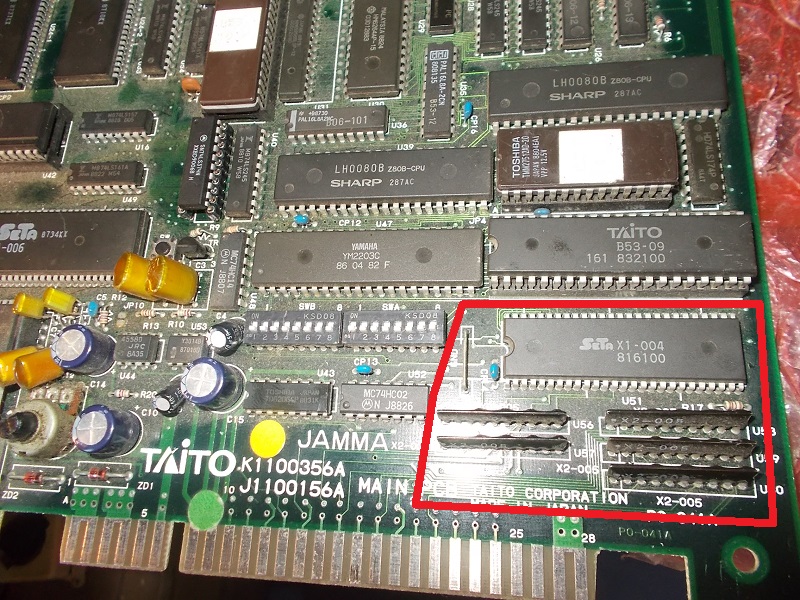
Resistor arrays did their job by pulling-up the signals and then routing them to the custom so most likely the ‘X1-004’ was bad.I played the card of replacing it but I had to struggle before finding a good spare as it seems this custom is quite prone to failure.I tried two donor parts but they were faulty until I caught the good one:
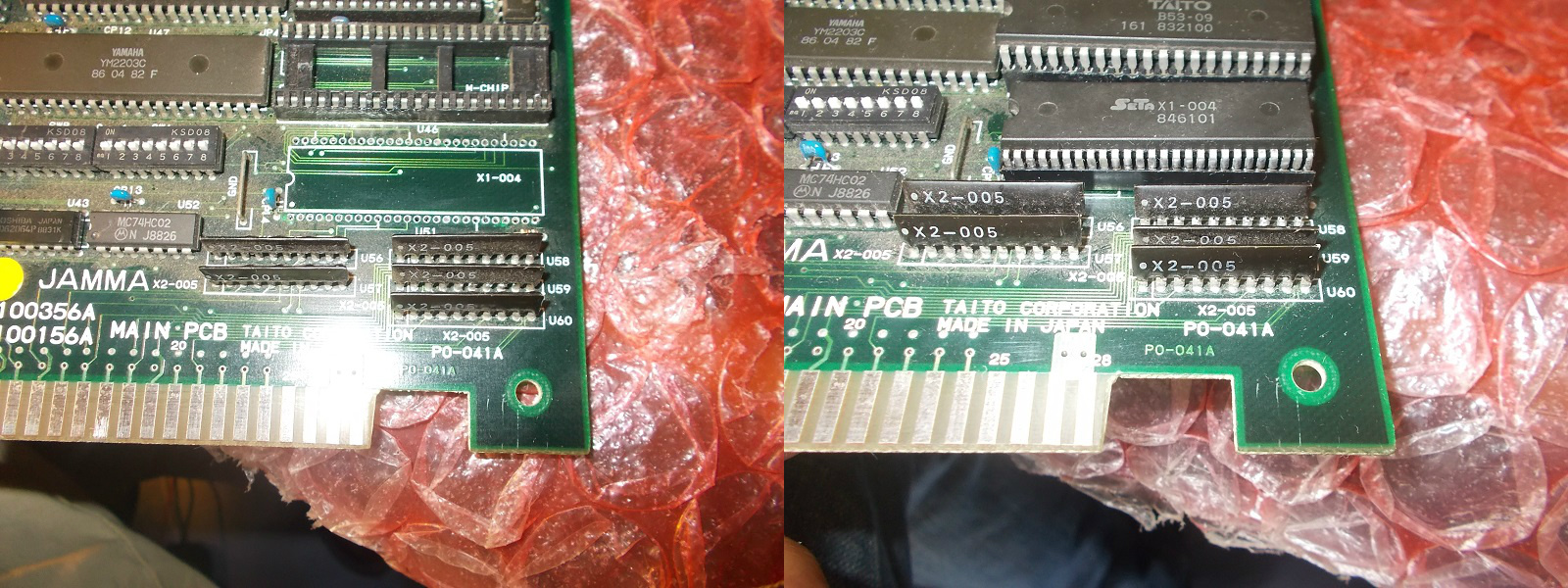
This fixed the controls and board completely.Repair accomplished.
Received for repair from New Zealand an original Bubble Bobble PCB.Set is made of a CPU board
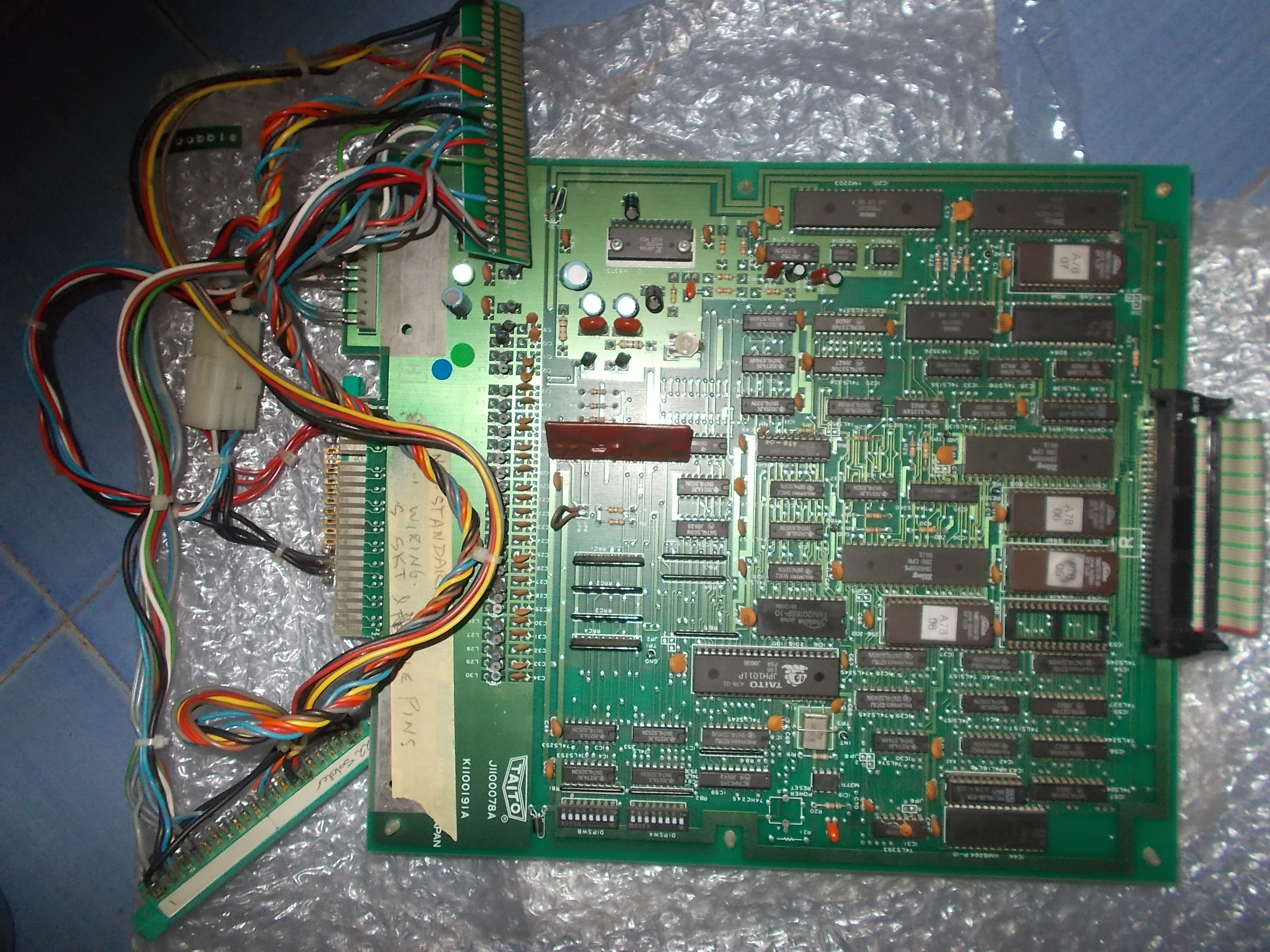
And a VIDEO board:
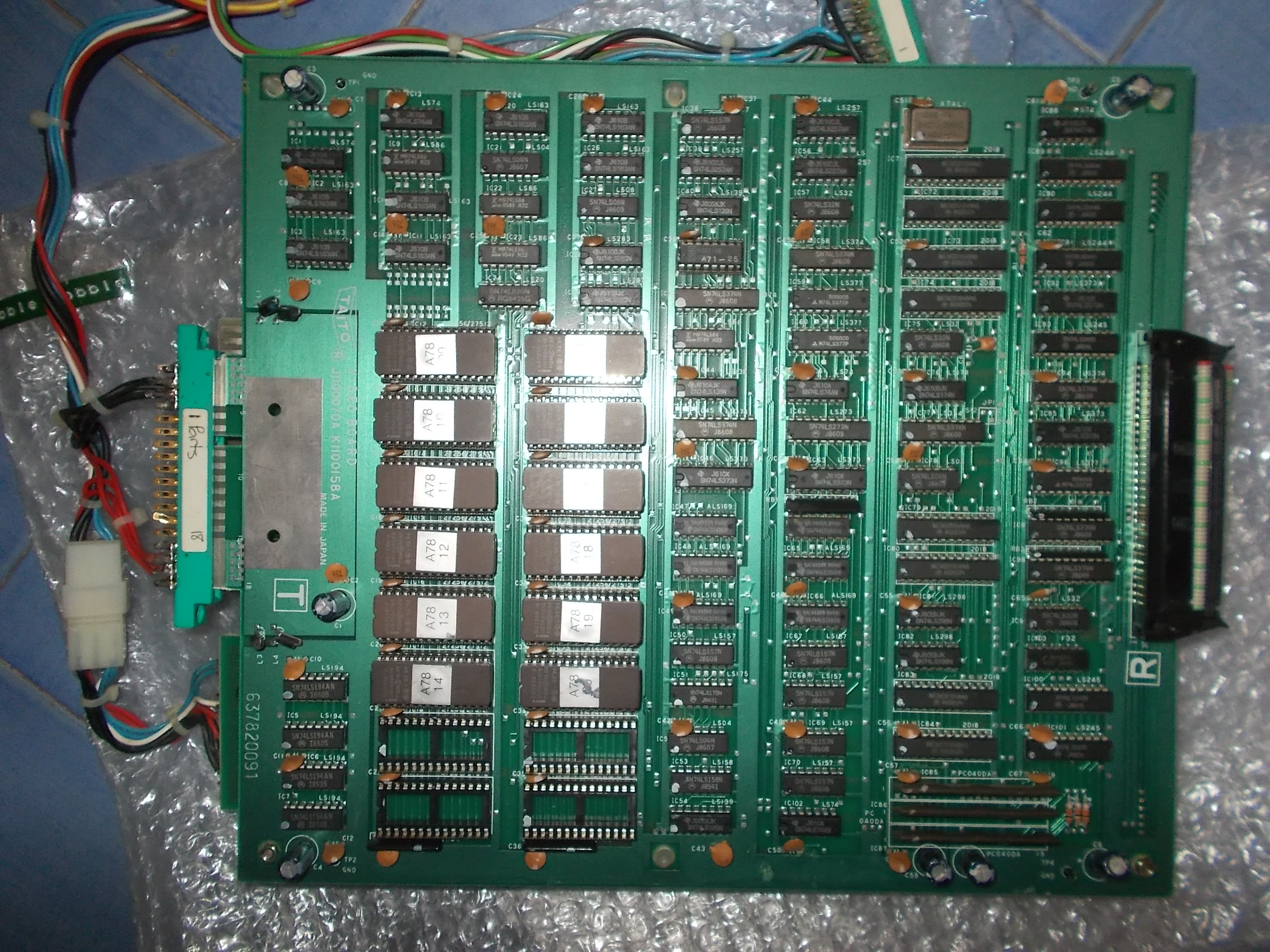
It came already adapted to JAMMA so it was just matter to plug it in.I did it but nothing came up on screen. I noticed wires were soldered onto the pins of ‘H’ connector and then a molex connector was used to carry power to JAMMA fingerboard:
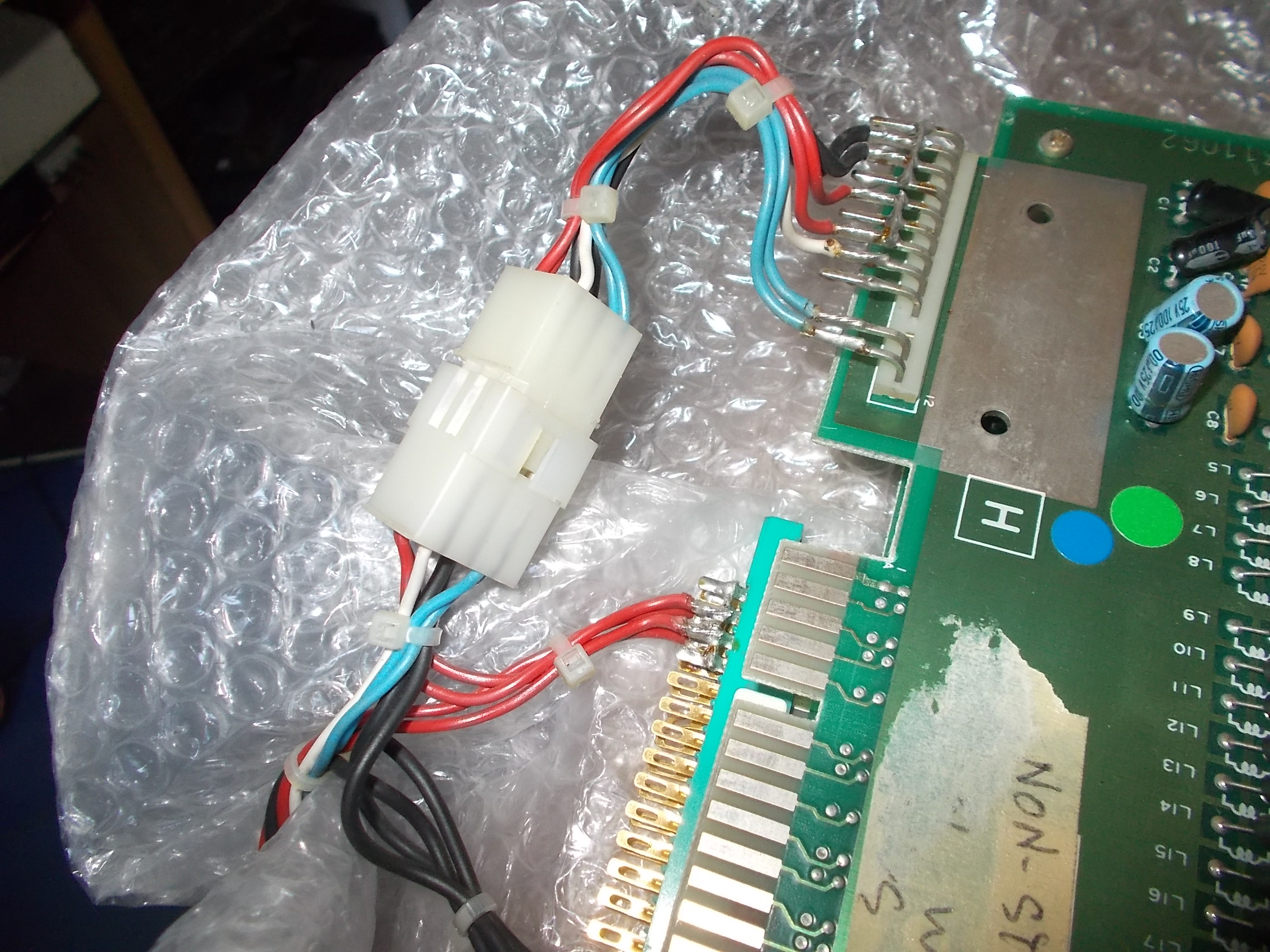
I didn’t like this solution because it can cause loose connection so I removed the molex connector and soldered wires directly to JAMMA fingerboard.In this way the board properly booted up, games was perfectly playable with sound too but every alternate horizontal line of graphics was missing :
From top of my experience I know this kind of issue are most of times caused by bad counters (74LS161/163/169).Looking at board I spotted two rows of 74LS169 on bottom VIDEO board:
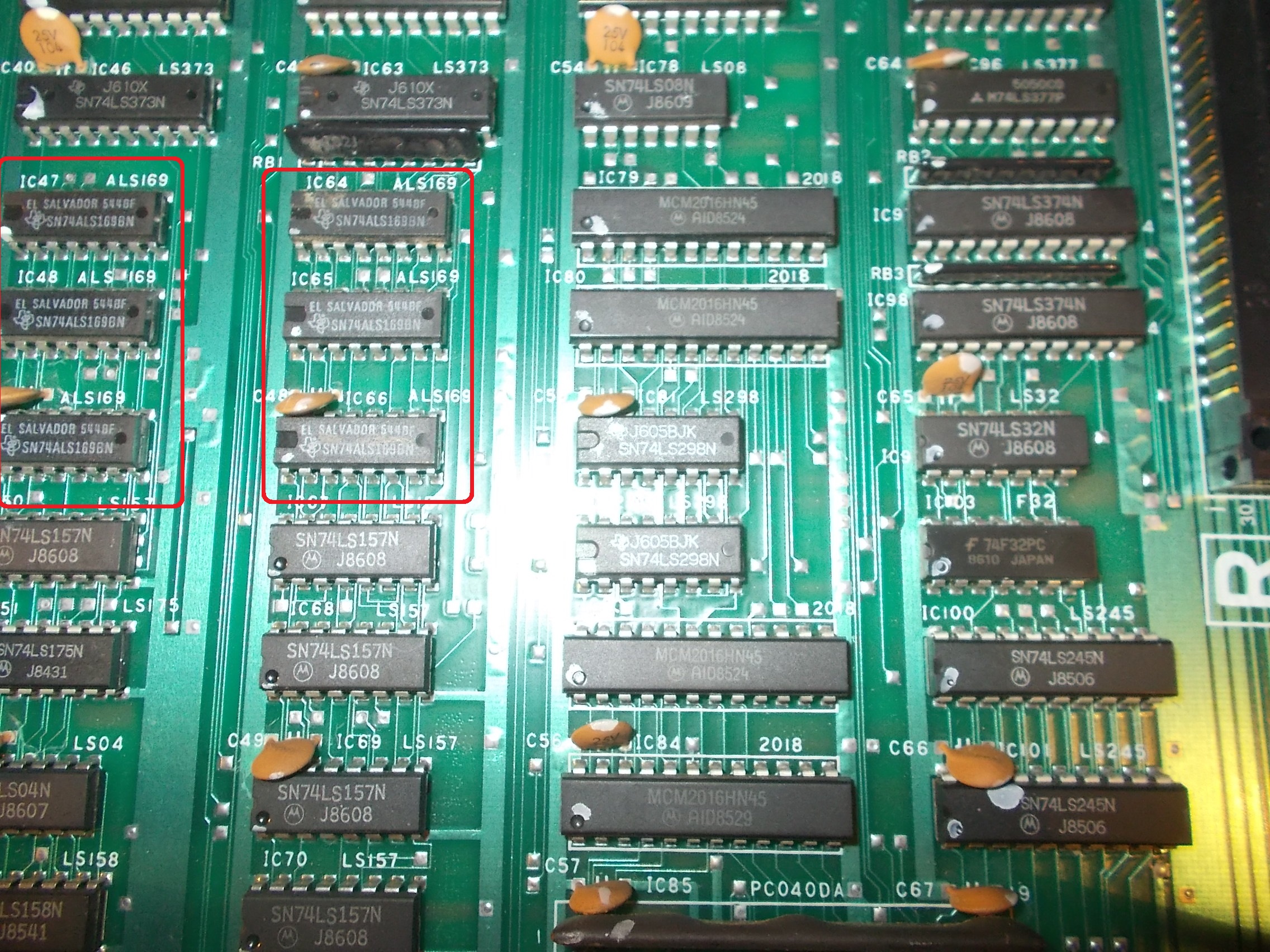
From schematics I could see they are involved in VIDEO RAM data bus, this made sense :
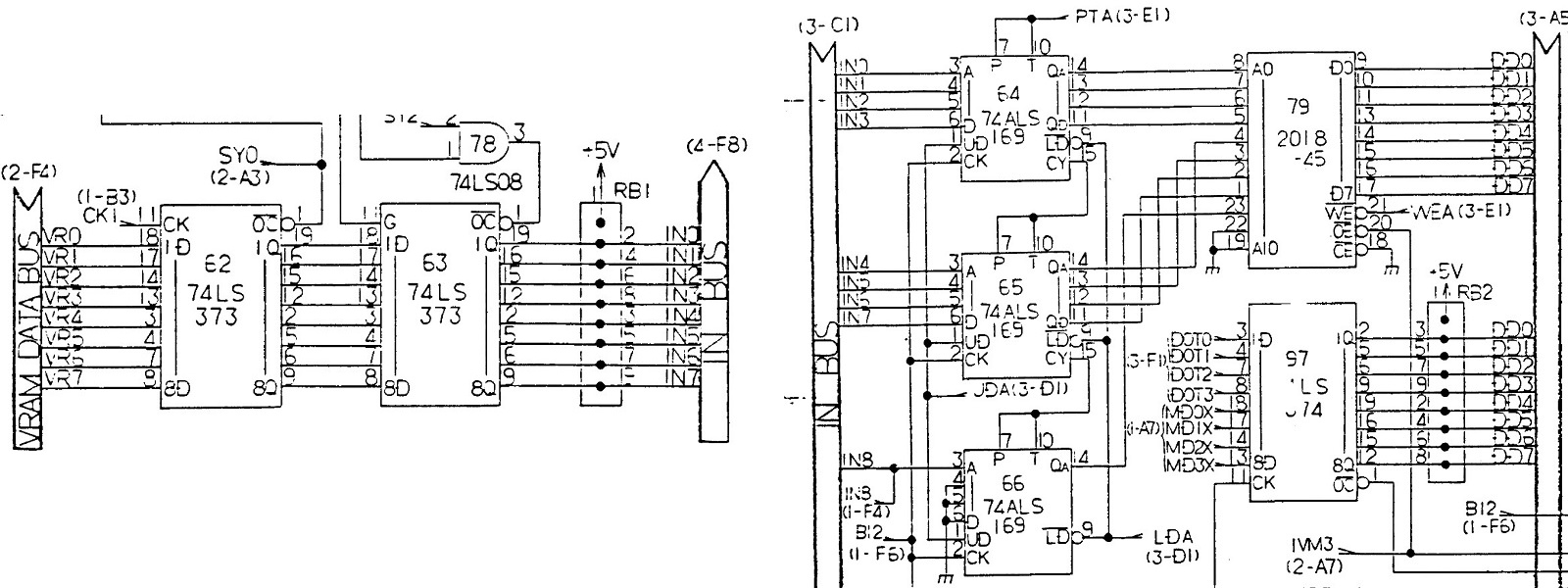
I went to probe these 74LS169 in circuit with my HP10529A logic comparator, all of them passed the test except the one @IC64 that gave troubles on all its outputs:
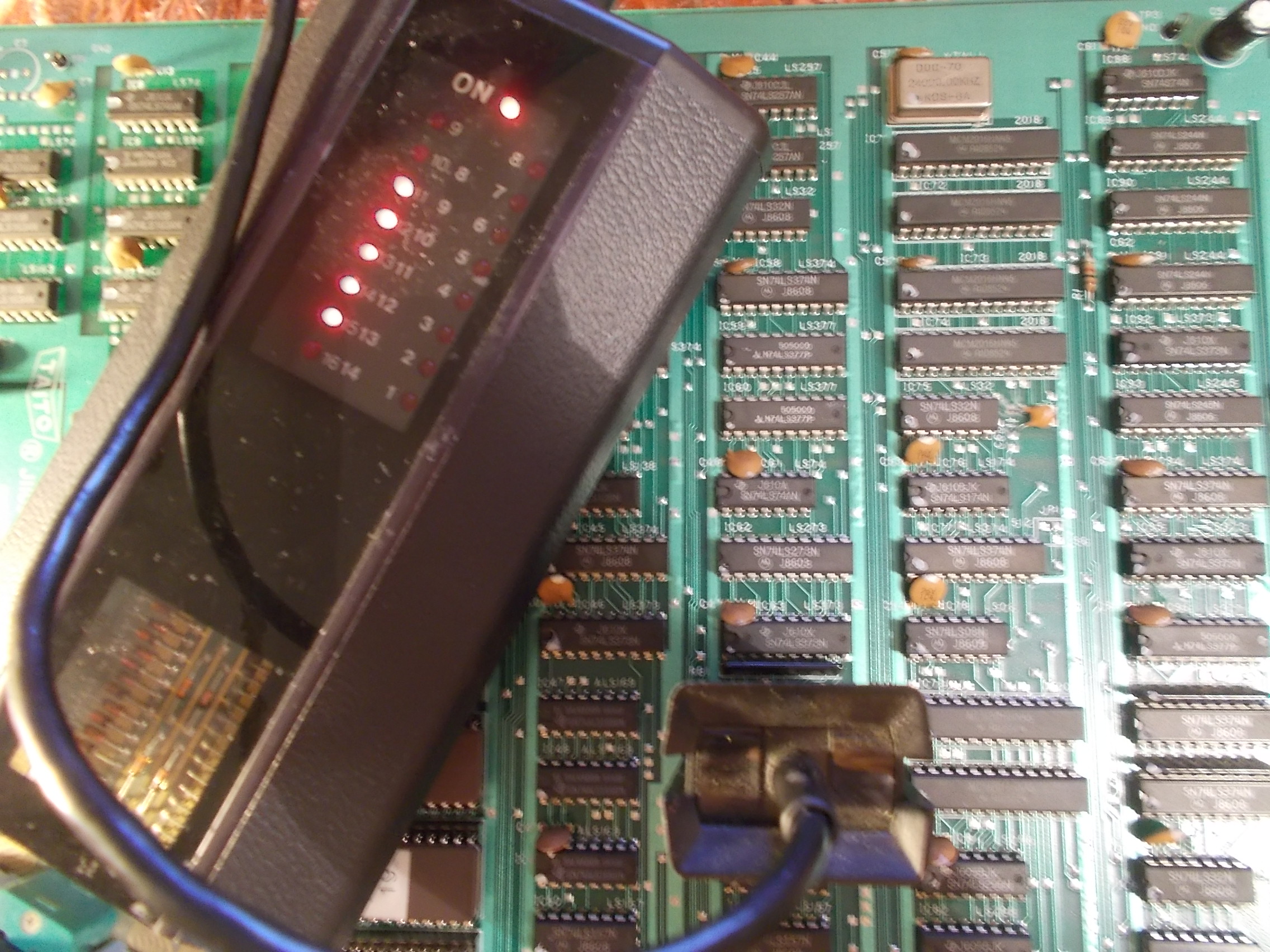
I pulled the part out :
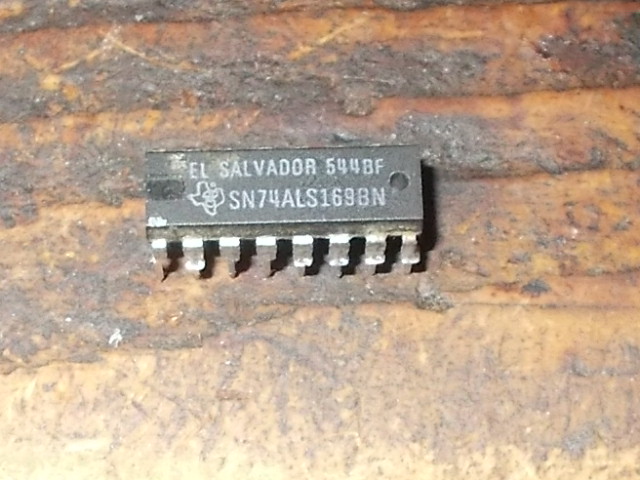
It failed the out-of-circuit test on my BK560 :
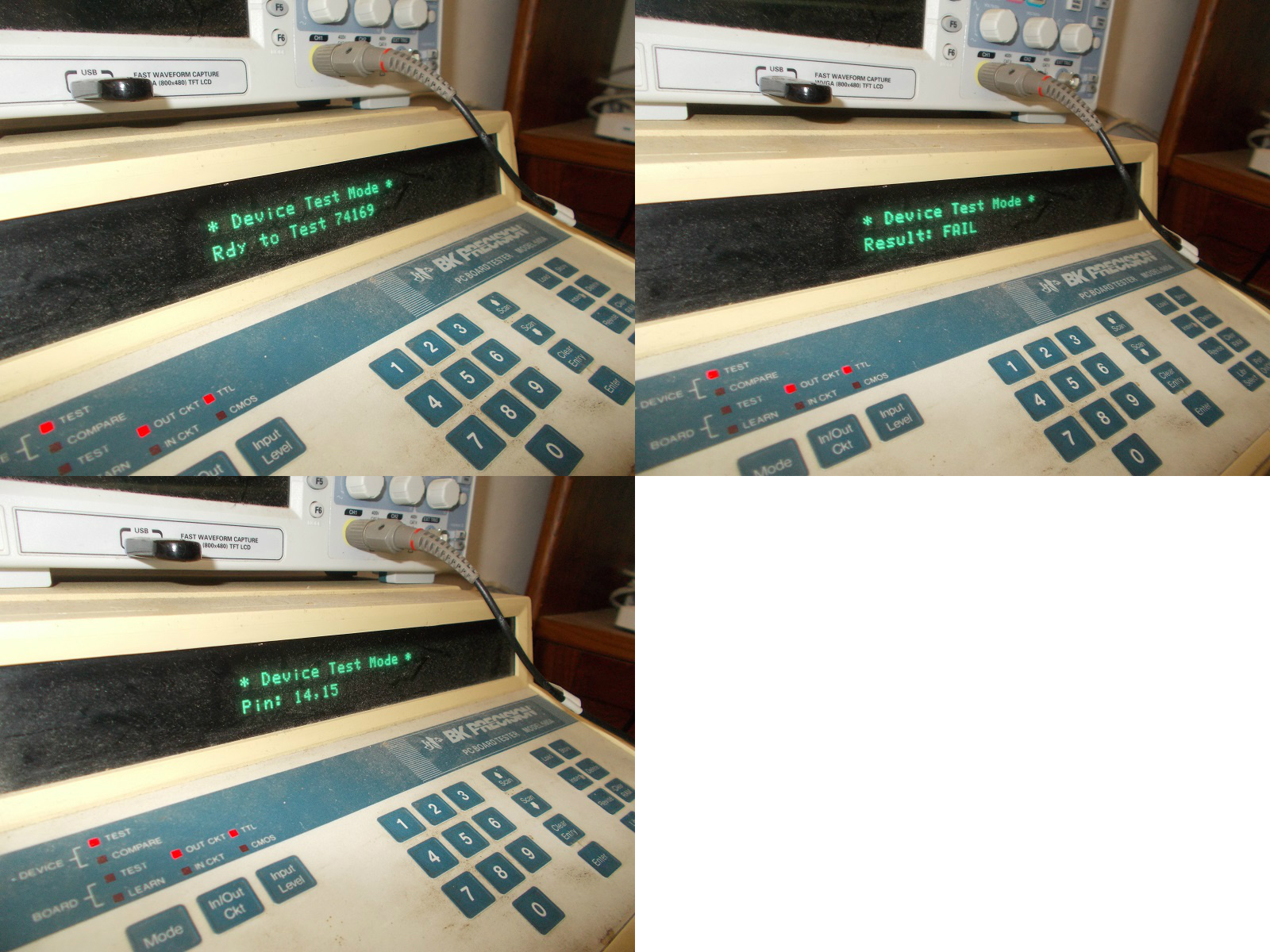
I installed socket and a fresh IC :
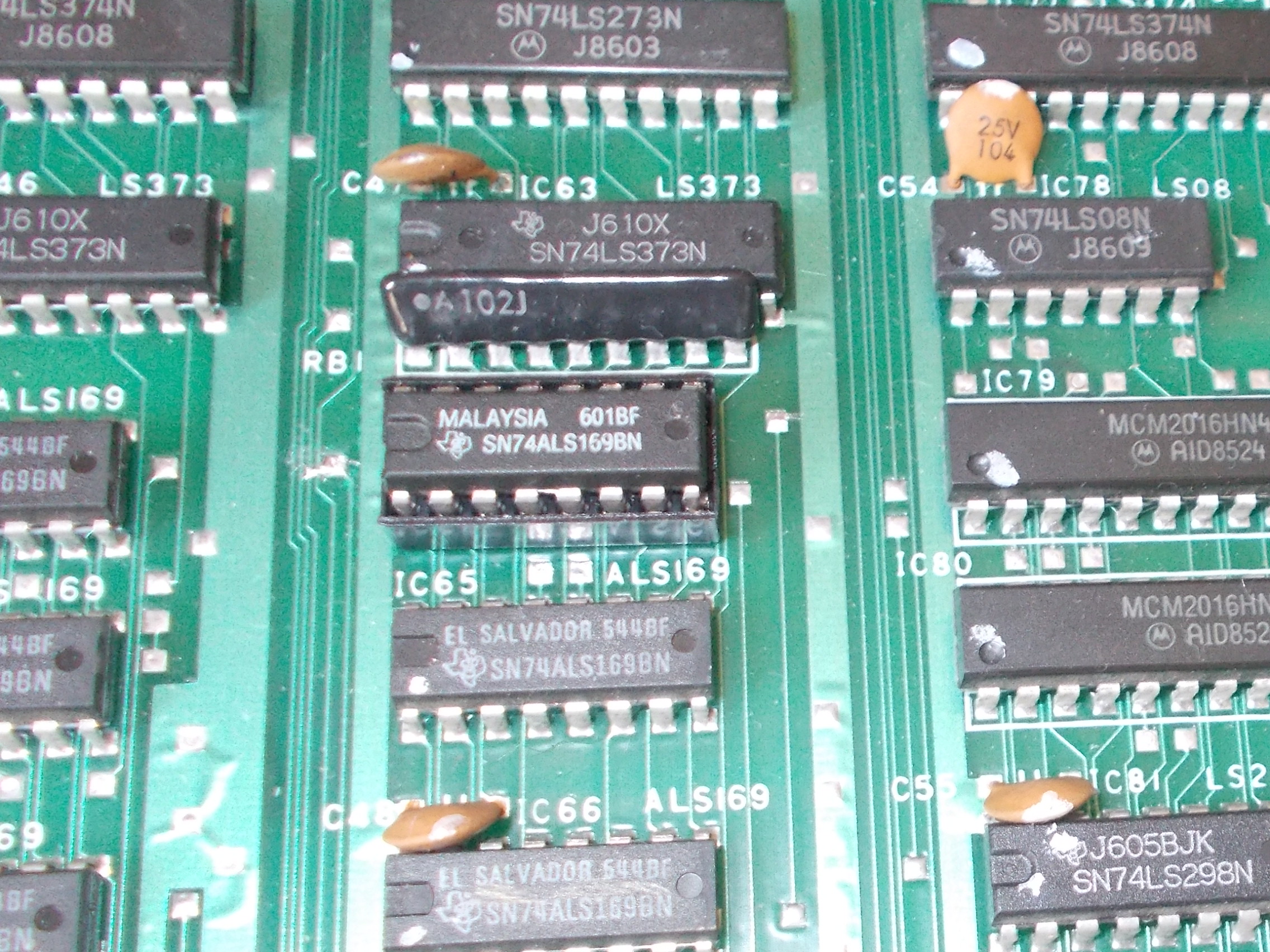
This cured the issue and fixed board completely.End of job.
I received from Portugal a couple of Space Invades DX PCBs, a game released in 1994 by Taito (more or less a port of the original Space Invaders, with a few new features).
Both boards were in very good condition but completely dead.Here’s the first one:
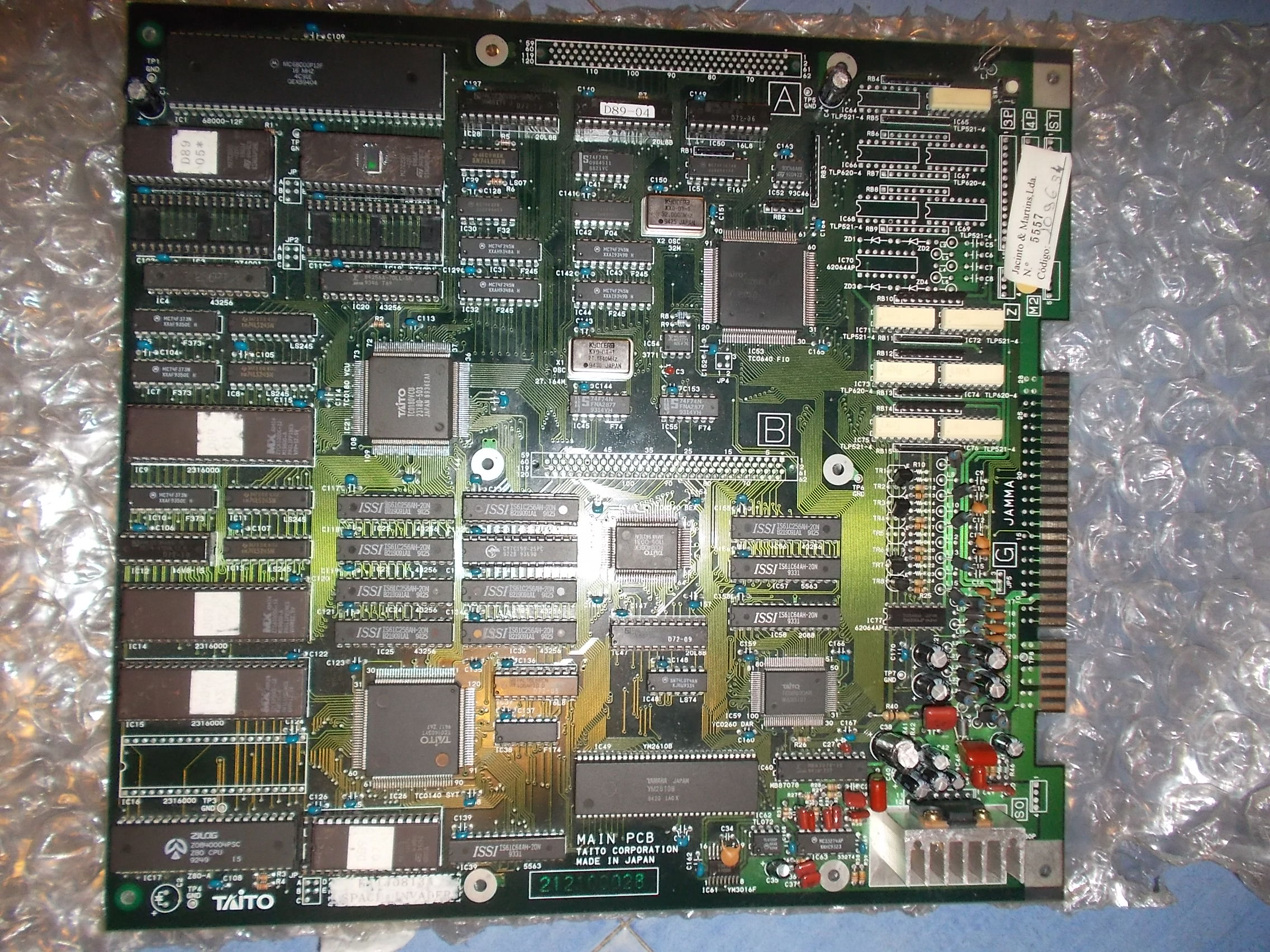
All I got on power up was a steady black screen.Probing the 68000 main CPU revealed the address/data busses were active but the three interrupts inputs (IPL0-IPL1-IPL2) were all in fixed high logical state.I traced these inputs back to a PALCE20V8 marked ‘D72-07’ :
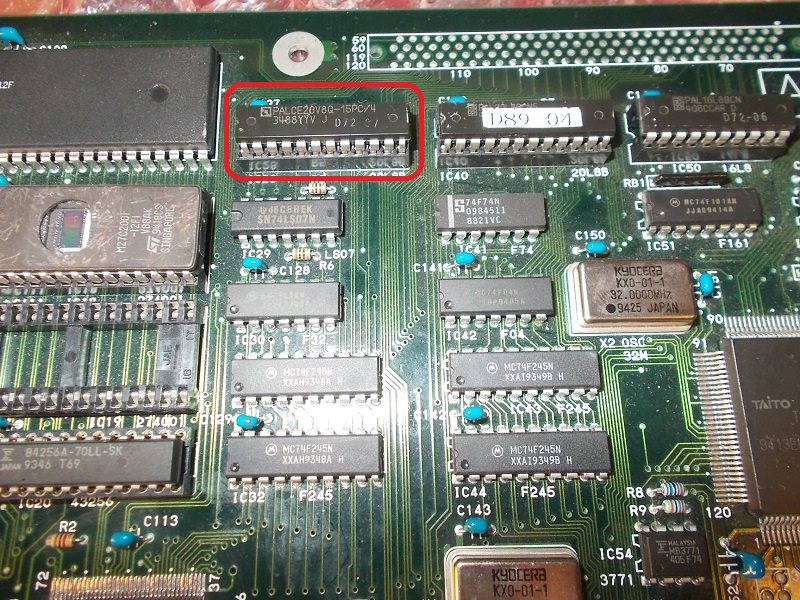
Then I disassembled the fusemap of the MAME dump of this PAL being able to identify its inputs and outputs:
/** Inputs **/
Pin 1 = i0;
Pin 2 = i1;
Pin 3 = i2;
Pin 4 = i3;
Pin 5 = i4;
Pin 6 = i5;
Pin 7 = i6;
Pin 8 = i7;
Pin 9 = i8;
Pin 10 = i9;
Pin 11 = i10;
Pin 13 = i12;
Pin 14 = i13;/** Outputs **/
Pin 15 = o15; /**(Combinatorial, No output feedback, Active low) **/
Pin 16 = o16; /**(Combinatorial, Output feedback output, Active low) **/
Pin 18 = o18; /**(Combinatorial, Output feedback output, Active low) **/
Pin 19 = o19; /**(Combinatorial, Output feedback output, Active low) **/
Pin 20 = o20; /**(Combinatorial, Output feedback output, Active low) **/
Pin 21 = o21; /**(Combinatorial, Output feedback output, Active low) **/
Pin 22 = o22; /**(Combinatorial, No output feedback, Active high) **/
Pin 20-21-22 were outputs to 68000 interrupts lines and they were confirmed to be stuck high along with all other outputs :
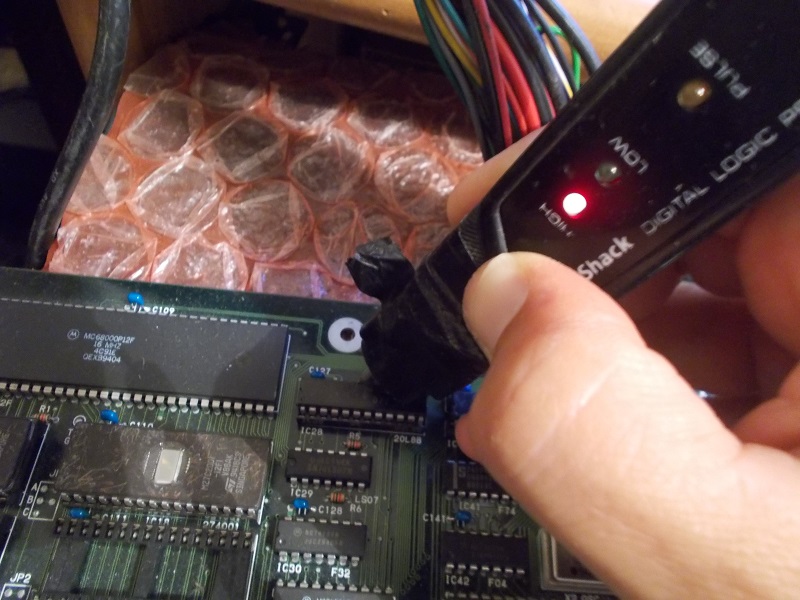
Although PAL was secured I tried to read it in my programmer, this would have at least told me the state of ‘health’ of the chip.Reading failed hence the chip was faulty:

I burned a GAL20V8 (GAL and PALCE are most of time interchangeable) with MAME fusemap :
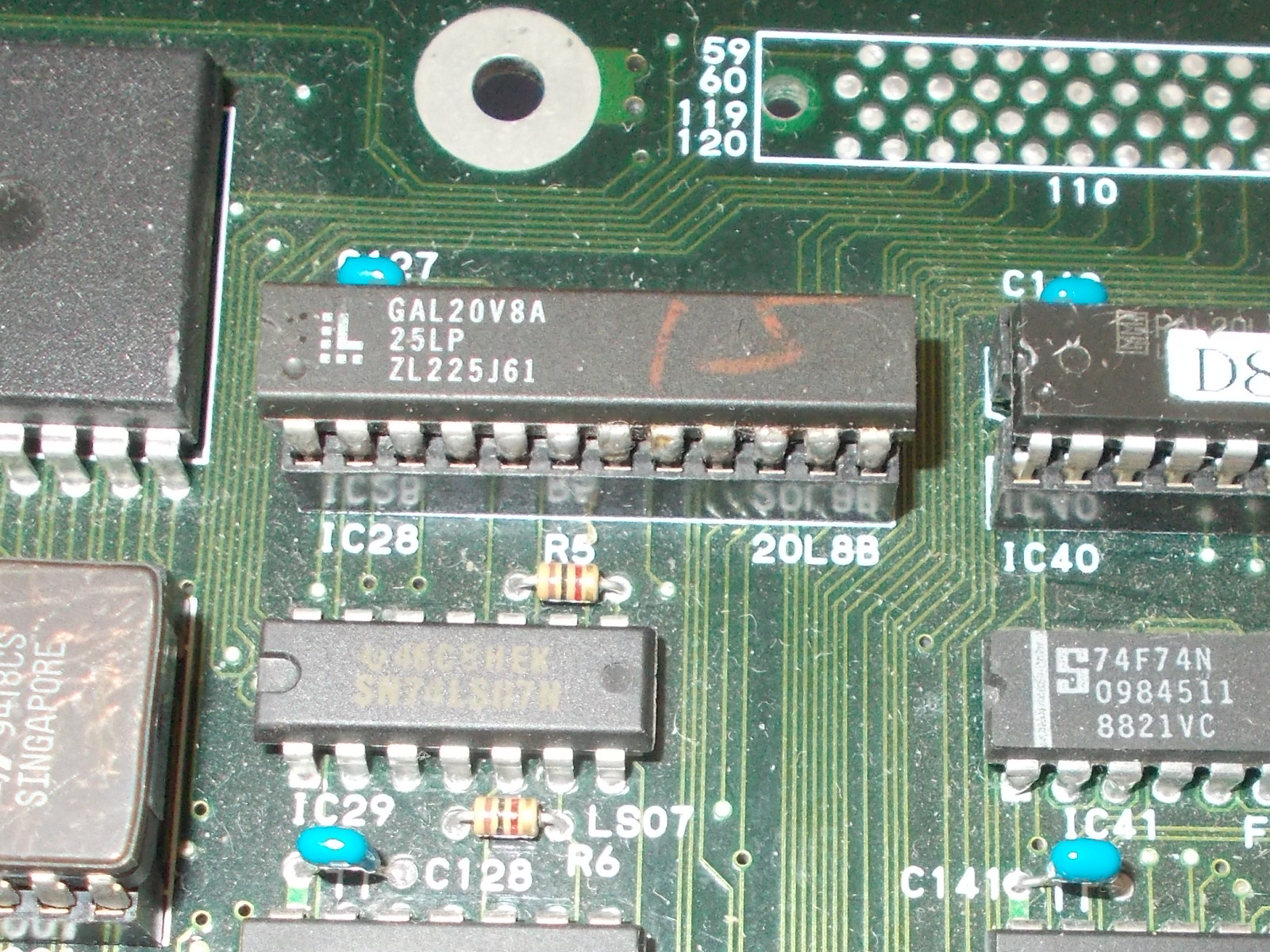
Board booted up with no further issue.First board repaired.
The second board:
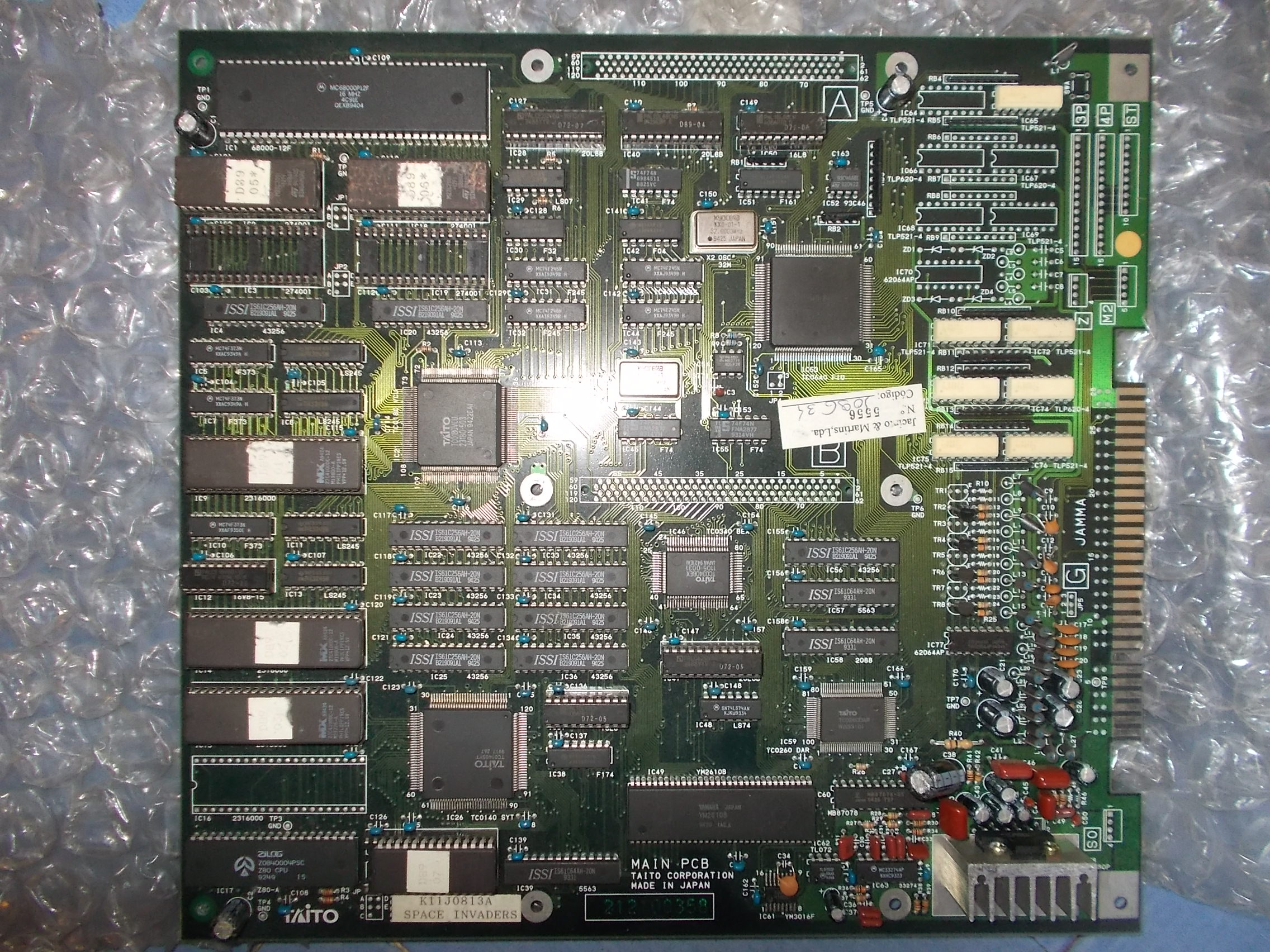
As said, it was completely dead.Probing the 68000 main CPU revealed the clock input was stuch high:
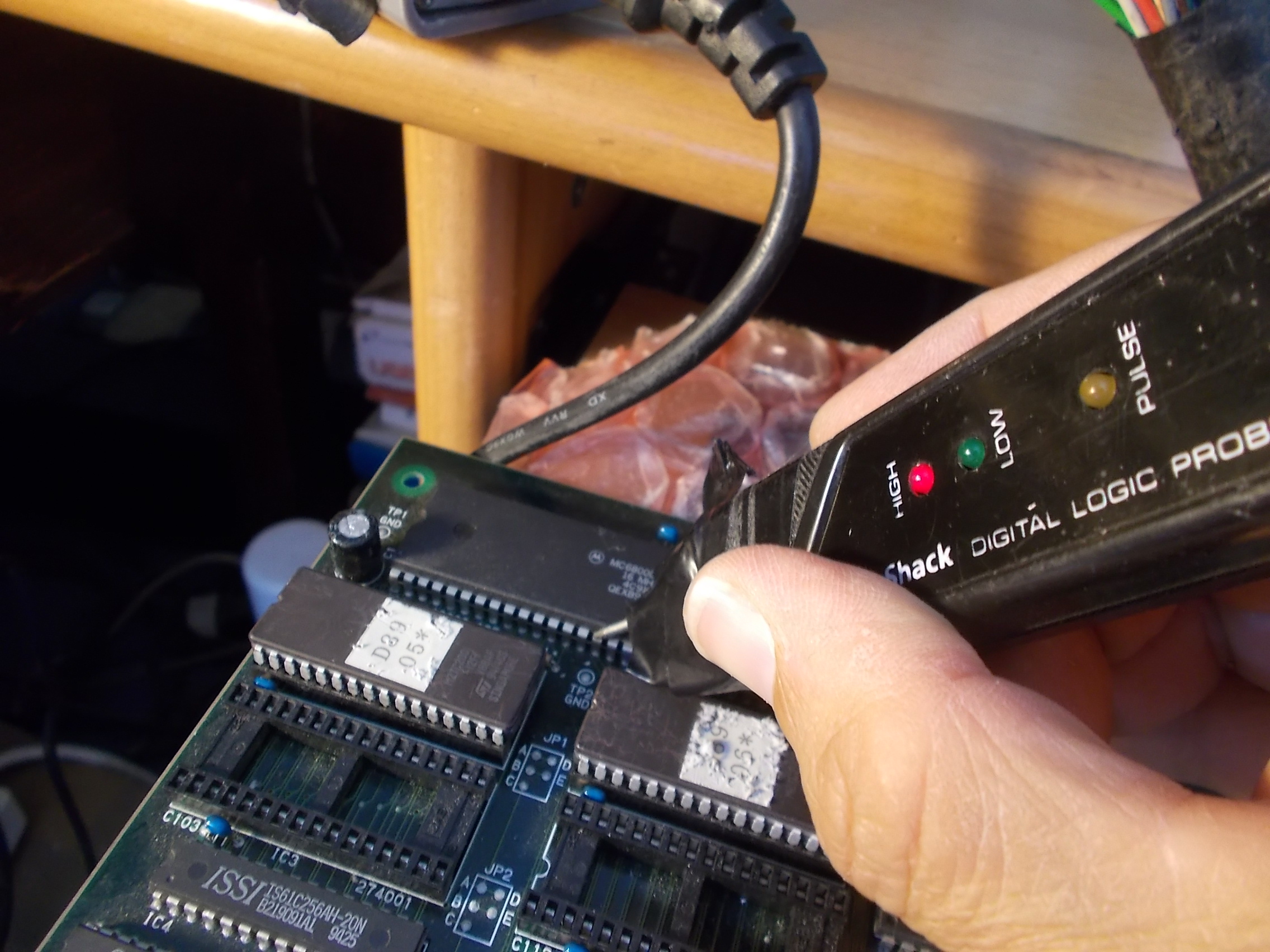
I traced it back to a 74F161 @IC51 which acts as a clock divider of the 32Mhz signal generated by the near oscillator :
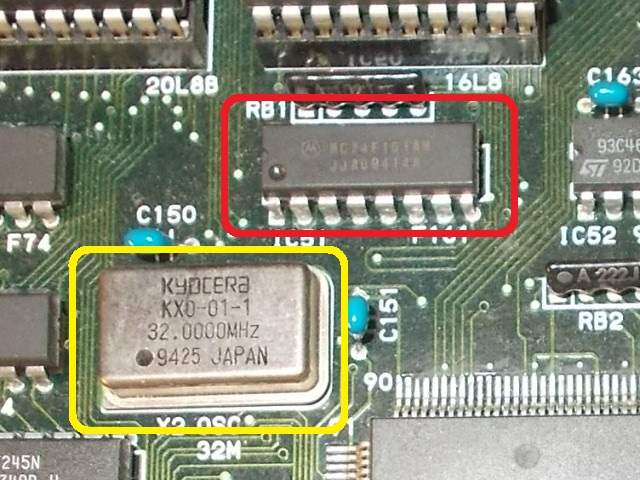
There was nothing coming from the oscillator into the clock input (pin 2) of this 74F161 counter:
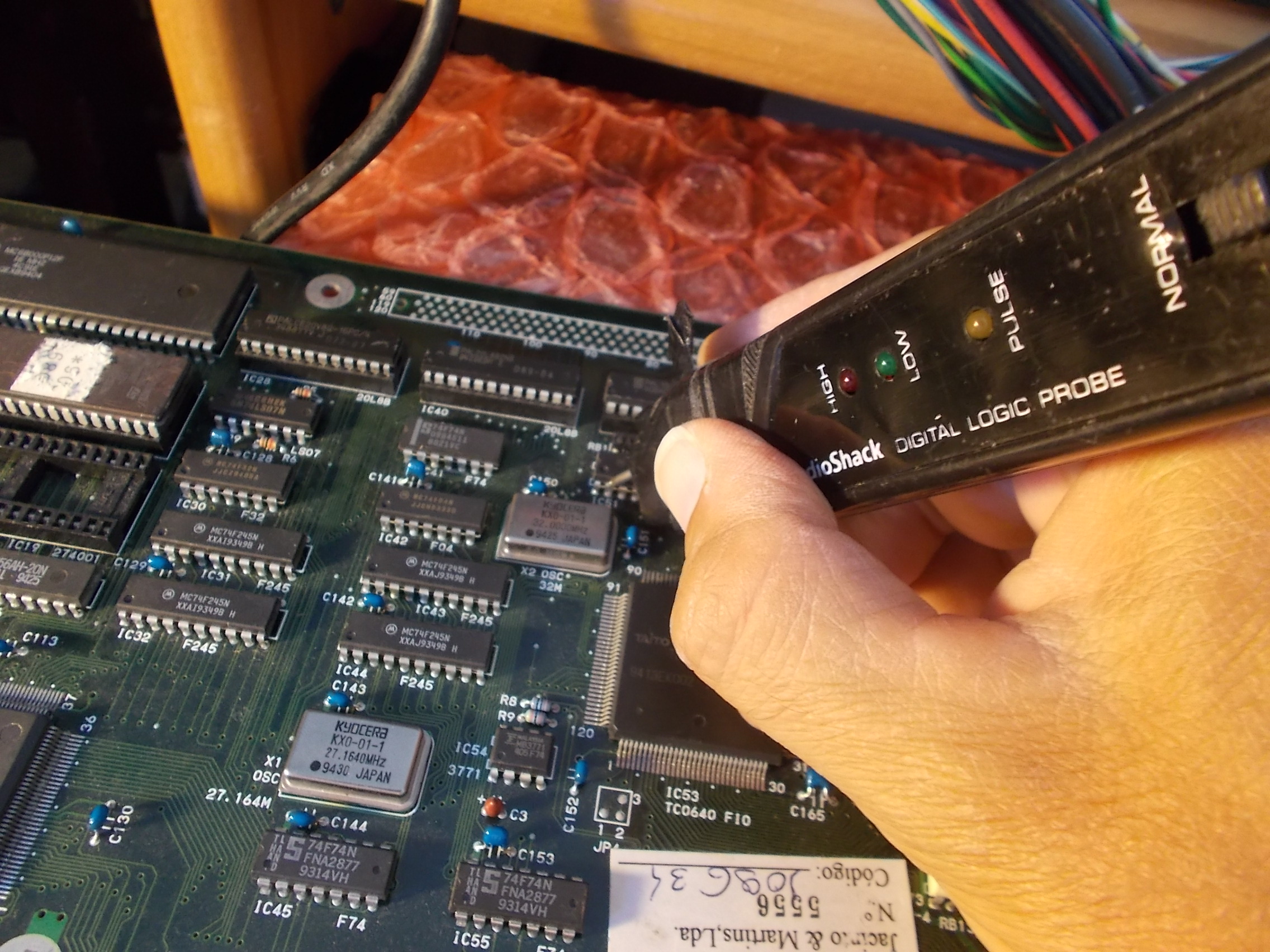
At first glance I thought the oscillator was dead but before replacing it I made a visual inspection on solder side.I found a dry joint on its output pin :

I promptly reflowed it and then powered up the board again.It booted up with no further issues.Double repair accomplished.
For Atari 800XL, 800XLF, 65XE and 600XL 64kb home computers.
Diagnostic program – previews
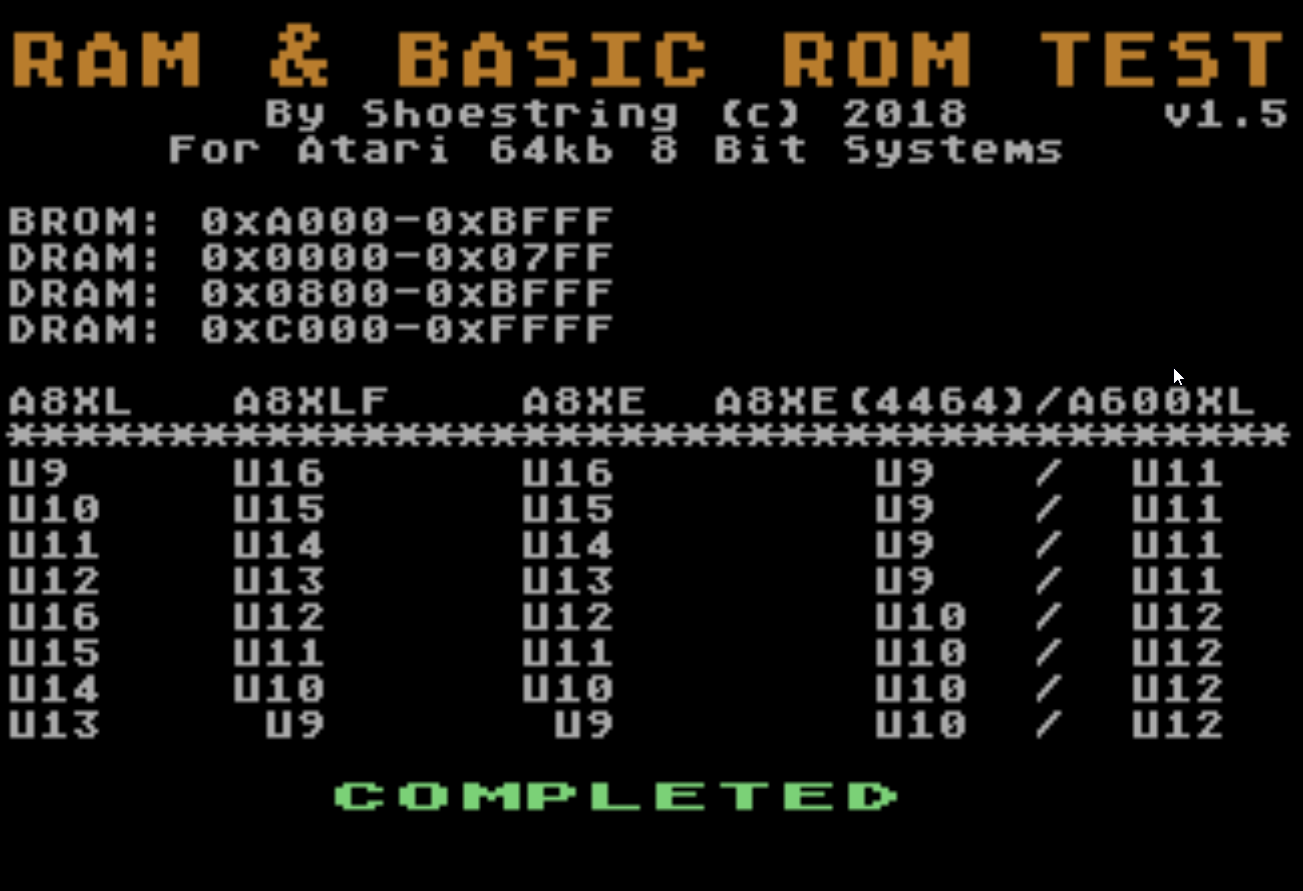
This program installs in the OS ROM socket and is used as a means for testing the DRAM and the Atari Basic ROM. If you have some spare 27c128s lying around then this can easily be installed without an adapter in any Atari 8 bit.
When the program first fires up you’ll see a black screen & hear an annoying sound as the data is being written to the first 2kb of DRAM, this is intentional and to let you know that the program is busy writing data and evaluating it. The first chunk of memory is critical to test as this contains page zero and work ram used for assembler programs accessing shadow registers..etc
Memory test algorithms used
Example of walking 1 bit pattern evaluation
This writes the bit pattern directly to PMG address space which is visible on the right hand side of the screen in red.
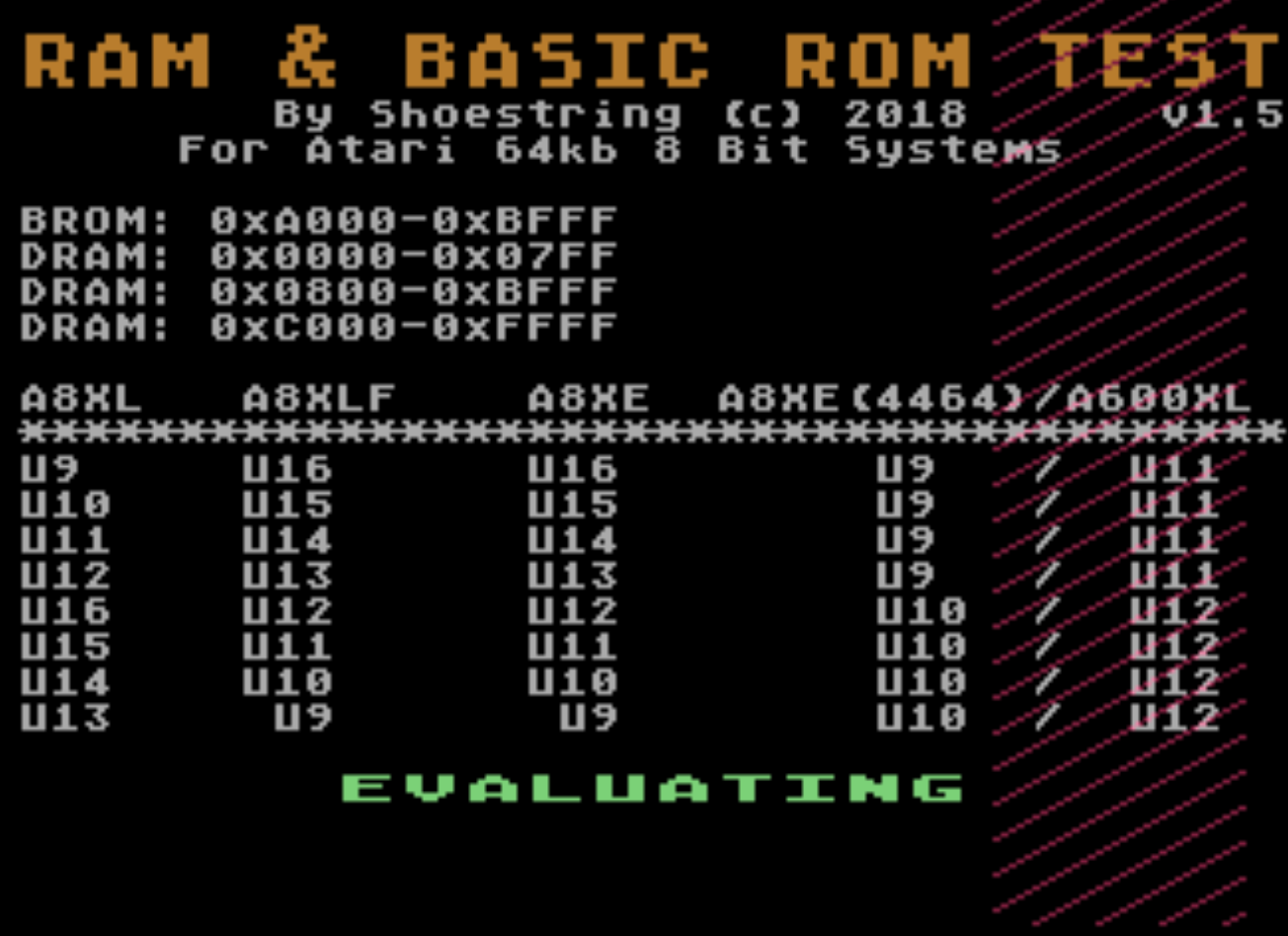
Bad ram detected in the 0x800 to 0xBffff memory region ( the arrow indicates a bad data bit was read back )
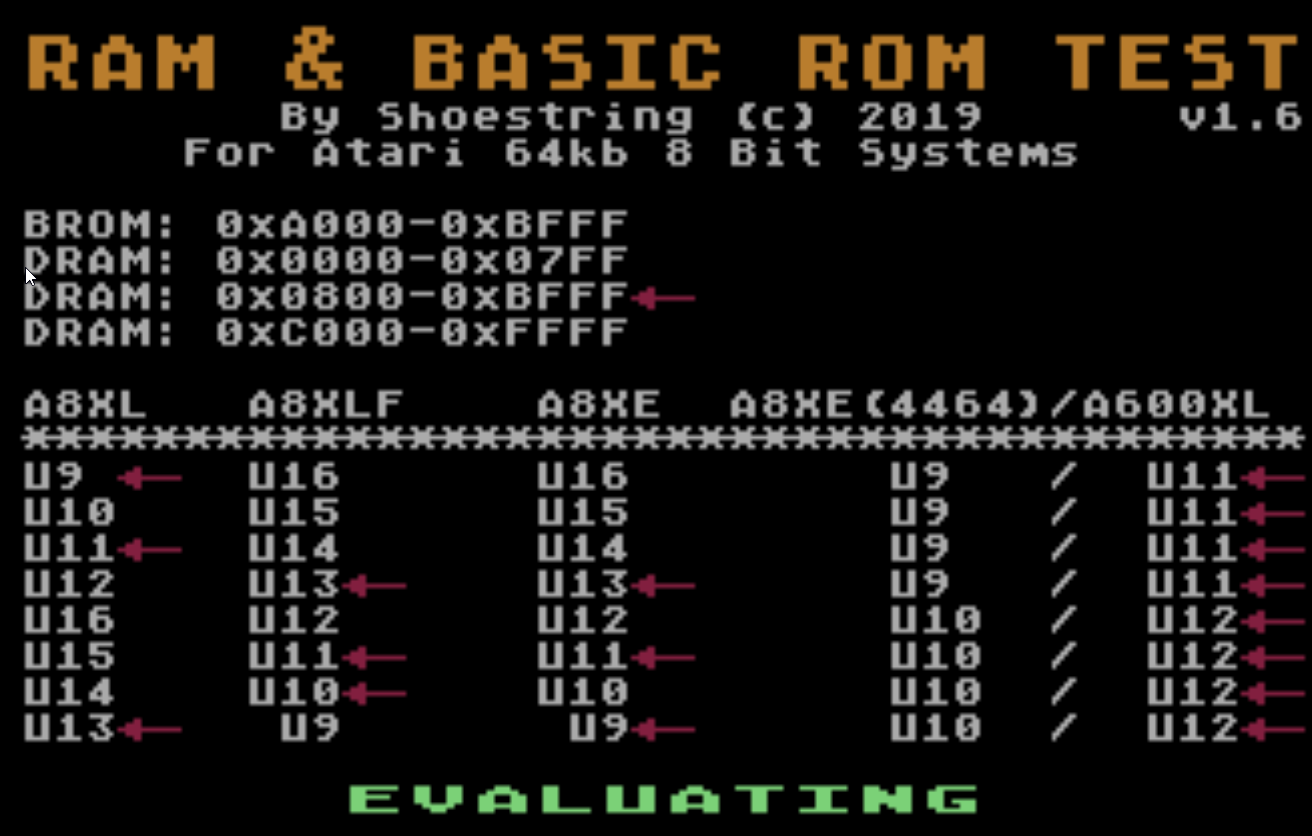
What it does
Note: This does note evaluate the memory underneath the I/O ( 0xd000 – 0xd7ff ). As there is no possible way ( that I know of ) to access it like you can in the Commodore 64 via bank-switching. Programs do not utilise this area of memory anyway.
Pre calculated Basic ROM checksums 16 bit [ sum of bytes ]
Advantages of using the ROM
Note – Chips that get hot to the touch including DRAM chips indicate an internal short. This should be addressed prior to using this diagnostic tool. +5 voltages below 4.75v will cause instability and unpredictable results. First remove the suspected chip from the machine then power the machine on and confirm no other chips are getting hot to the touch before installing the replacement chip, this is to prevent the possibility of damaging the replacement chip, confirm no short present by checking the +5v reading at one of the chips.
Do not use this diagnostic tool if you have not verified the operation of the power supply.
Limitations
To Do – In future version.
What I probably won’t do
Download
Download link 1: a8diag1-6.rom
Download link 2: a8diag1-6.rom
DRAM configuration of 600xl
This tool is compatible with the following DRAM configuration in the 600XL which requires two 4464s installed in the original sockets with 3 additional wires. See following link for instructions. If you use a 3rd party RAM expansion board, then chances are it will have 8 x 4164 1 bit DRAMs. Whilst you can certainly check the integrity of the RAM on the board using this program, you’ll most likely need to identify the bad chips yourself.
This is the cleanest method in my opinion as it does not require soldering any wires to the board and is easily reversible.
